Smith & Wesson recently released the M&P380 Shield EZ. It’s designed to be easy to operate, easy to shoot, easy to load, and easy to field strip. And, as reviewed here, they #NailedIt. But Walther’s PK380 has been a fit for recoil-sensitive shooters and for those with diminished hand strength for nearly a decade. So, how do they stack up?
 On paper, the two pistols are extremely similar in size. Their length, barrel length, height, and width stats are all within a tenth of an inch. Weight of the two guns is within a half ounce. Their 8+1 capacity is identical, as are their $399 MSRPs.
On paper, the two pistols are extremely similar in size. Their length, barrel length, height, and width stats are all within a tenth of an inch. Weight of the two guns is within a half ounce. Their 8+1 capacity is identical, as are their $399 MSRPs.
But that still leaves significant room for differences, of which there are many.











With the slide forward, locking a fully-loaded magazine into the Shield EZ is far too difficult, but it’s a cinch in the PK380. With just a pinky finger I can slide the magazine up until it clicks with light pressure. In this category, the PK380 has a clear advantage over the Shield EZ. I fear any user buying the EZ for its ease of use will end up carrying it with a round under its full capacity.
Unfortunately for the Walther, slide-forward loaded magazine insertion is the just about sole category in which the PK380 is the better gun.











The PK380 audibly rattles and wobbles. The squarer-than-a-GLOCK’s-slide slide (machining time costs money) is loose on its rails. It clacks around both top-to-bottom and side-to-side. It’s also Cerakoted, which is fine but, not as impressive or as durable as the EZ’s nitride treatment.
The Smith feels like a polymer-framed semi-auto should, with appropriate clearance between slide rails and frame rails. Its nicely-machined slide moves freely, but without the rattle.
Slide serrations on the PK380 are shallow, though the slide-mounted safety provides an annoying back-up for slipped fingers. Finger purchase on the Shield EZ is significantly better. Though its serrations span a shorter length of slide, they’re far more effective.
Furthering the overall cheap feel, Walther puts plastic sights on the PK380 whereas Smith chose steel for the Shield EZ.






















If you choose the model with the manual thumb safety, that safety is mounted in an easy-to-reach location and it’s easy to operate. Likewise, the magazine release is easy to reach and works in the U.S.-standard manner. Field stripping the EZ is as simple as rotating the takedown lever down and pulling the slide off the front. Finally, the EZ has only one mode of operation. Oh, it also has a slide stop.
The Walther is complicated and difficult to operate.
Its slide-mounted safety is hard to reach and awkward to operate. Flip it up to fire and down to block the hammer. Which is also a bit awkward, as the lever serves solely to prevent the hammer from hitting the firing pin. The trigger is still fully functional, the slide can be racked, etc. For whatever reason, the owner’s manual still suggests pinching the hammer to lower it slowly after pulling the trigger instead of just pulling the trigger and letting the hammer fall home.
In fact, double action / single action external hammer operation is complicated in general. Multiple modes of operation adds complexity to what is often suggested as a beginner’s gun.











Yes, while most shooters warm up to a paddle release after practicing with it for a while, for those with limited finger strength, reach, and dexterity the PK380’s release is objectively more difficult to use than the EZ’s.
Field stripping the PK380 requires the use of a special key. Insert the key into a hole in the left side of the frame, rotate it 135 degrees, and then pull the takedown levers down in order to release the slide. They key remains in the frame until the pistol is reassembled. Special tools are complicated.
Slide stop? Who needs a slide stop? The PK380 doesn’t have one. This is because…you see…nope, there’s just no good reason. Locking the slide back manually requires first inserting an empty magazine. When the slide locks back on empty, there’s no way to return it to battery other than ejecting the magazine and sling-shotting the slide (with or without inserting a fresh mag). This is weird.
Between the lack of a slide stop and a safety that’s really just a hammer block, allowing full-on trigger pulls and a dropped hammer in both SA and DA, and generally complicated operation all-around, I have safety concerns with the PK380. So did Walther, apparently, as half of 2012’s production was recalled for firing even when on “safe.”











Not so much on the PK380. Not any of that. The trigger pull in both DA and SA is horrible, despite Walther’s website stating “Best Trigger on the Market.” In fact, the trigger pull is heavy and gritty — generally unpleasant — and stacks hard right before the break. The tight curve of the trigger is uncomfortable, particularly when it’s far forwards in DA mode. Which will also make it hard to reach for smaller shooters. Its serrations actually create sharp edges that are also uncomfortable. This is not a nice trigger in any way.











So, PK380 owners will want to manually cock that hammer before manipulating the slide. But the hammer is small and cocking it takes real finger strength. This is not a good fit for much of the target audience.
Finally, when racking the slides with the hammer cocked, it’s still easier in the case of the Smith & Wesson. Not by much, but the Walther hits a noticeable wall when the slide contacts the hammer and pushes it even farther down, whereas the Smith does so to a significantly lesser degree.











The Smith recoils more softly, both in felt recoil to the palm and in muzzle flip. Combined with a grippier grip texture and the ability to get a higher grip on the gun, it’s much more controllable and pleasant to shoot. That ergonomic, crisp, 4-lb trigger adds to the positive experience.











But stay tuned as our man Jon Wayne Taylor has the PK380 in-hand along with 500 rounds of Freedom Munitions .380 ACP ammo (use coupon code “TTAG” for 5% off everything on Freedom Munition’s website, including the 16 brands of .380 ACP they stock). He’s putting the little Walther through the full TTAG review process now.



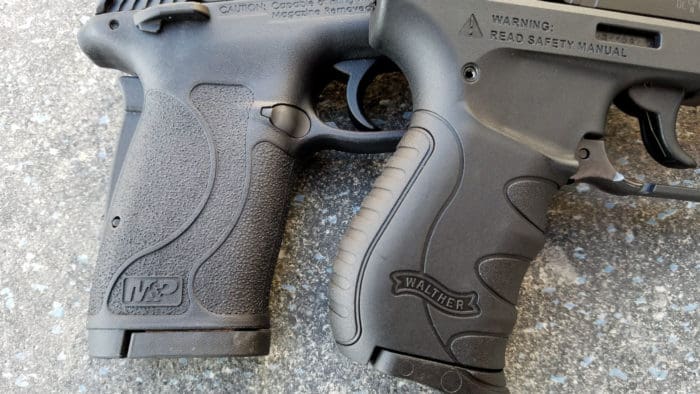






Isnt the PK380 a URMAX gun not a real Walther designed gun?
As an owner of a PK380, I definitely intend to examine a S&W as soon as possible. One thing to point out, the PK380 was distributed by S&W for many years. In fact, my PK380 has Smith & Wesson roll marked on the slide. One would expect that S&W used that experience to make some improvements.
All that being said, your “comparison” seemed to find the PK380 to be without redeeming features, save an easier to insert magazine. Certainly I will go out of my way to look at the S&W 380ez, and I do expect it to be good, just as I find my PK380 to be good.
I think may of your complaints are expression of preference rather than qualitative issues. That would include things like a different style of Magazine release. I dare say it even goes as far as a DA/SA style of operation.
As far as plastic sights, I notice that the sights on my Glock 42, and apparently the rear sight on my Kimber Micro 380 appear to be plastic while the rear sight on my Colt 380 Government Model are metallic. Of all of the four 380 pistols I have mentioned owning, in this letter, the ones on the Colt are the hardest to use. It seems that design matters more than materials.
As far as a general impression of build quality, I hope to find that the S&W 380ez is as great as you build it up to be. I will say that the PK380 does not seem to have the build quality of the Kimber, or even the Colt. However, I, owning both, place it about equal to the Glock 42. Both are good, both have quirks.
Again, I look forward to comparing the PK380 to the S&W 380ez on person.
Yeah, S&W had the import and distribution rights for Walther products starting in 1999 and they were the importer of record (hence your roll mark). That ended in 2012, though. There is no reason to believe any aspect of the Shield EZ was based on any aspect of the PK380, though. As far as I know, the M&P22 is the only S&W product sold that was designed and/or manufactured with Walther.
I don’t believe I’m expressing much personal preference here. I argue that DA/SA operation, a slide-mounted safety lever, and possibly the trigger guard paddle magazine release (in this case in particular, as it’s small and stiff) are objectively more complicated and more difficult to use. If the idea here is making an easy-to-operate gun, the Smith’s operation and controls choices are better. As is the method of takedown. And I think we’d all agree that steel sights are objectively better than plastic sights? The overall quality of the Smith is simply superior across the board, from machining to fit to finish to materials. It does not have to be on par with Kimber or Colt to be the vastly superior-quality pistol in this heads-up between it and the PK380. And both priced at $399, BTW, which is important to keep in mind before we go comparing it to a Nighthawk.
You’re forgetting about the SW99, but that’s really neither here not there for a conversation about 380s. But it does show a deeper history between the two companies than just the M&P22.
seems like Walther is dying out, quickly.
To add, I noticed your trigger comment in the video, I just checked the trigger on my PK380, it is about 5.4 pounds single action. The double action pull is, of course, much harder ( cannot give you a number there because my trigger scale only goes to 8Lb).
Walther states it’s 11 lbs in DA, but they also say it’s 4 lbs in SA and it definitely is not. Though on my example I’d believe 10-11 lbs in DA and my guess in SA is more like 6-ish. I didn’t measure it, though…just the ol’ finger dyno 😉
I’m hoping Walther will make a “2.0” version of the PK380. I’ve rented the PK a few times at my local range. It’s a well-behaved little pistol, and I like shooting it. I do agree with many of the criticisms of it, too, though. Build quality could be better, and I’d like to see some of the quirks or its design (including the lack of a decocker) addressed.
And the Smith lacks the stupid looking white paint advertising on the slide.
Nice comparison, thanks.
Wouldn’t the Ruger LC380 be another competitor in this niche?
The question was asked, “Wouldn’t the Ruger LC380 be another competitor in this niche?”
I will say no. The PK380, S&W 380ez, and others like the Beretta 84/85, are essentially, full sized pistols. The LC380 is a significantly smaller pistol. In similarity, they are both .380 pistols, and they both, not including the Beretta, employ a locking breech. However, they are vastly different pistols.
The LC380 is better compared to the Glock 42
Nice review.
Jeremy gets my vote to be the sole reviewer….even if he is a Canik fanboy.
I have a P22 Walther that I bought when training my son.
It is a good pistol but it too has that “we made a pistol out of an airsoft gun” feel.
So i passed on buying a PK380 cause it is basically a bigger P22.
Needing a special tool and the cheapy feel to the takedown ….. thingy…. are crap.
Walther can do better … and has on many of their pistol.
This new Smith seems to be a good pistol… I will give it a look.
Maybe do a head to head with a Beretta Cheetah.
Better yet- 3-way comparo: PPK/S vs. Cheetah vs. Bersa.
Whatever else it may have against it, that “look at me! I’m a Walther!” graffiti makes it a nonstarter for me.
I will take the PK380 all day long. After hundreds of rounds, including my awesome reloads, I have never had a failure of any kind with the PK. The grip feels like butta and it’s easy to shoot. Love it. The M&P Shield I had for a few months was a pile of garbage, sold that turd as fast as I could. The take down tool is a little cheesy but how often do you really need to take it down. PK-FTW.
I think the Walther is a good gun for the purpose. and I noticed in the video that slapping a fully loaded mag into it was ok. I have no problem with the double/single trigger as I like to carry my PPK/S which I think is a better gun. but to need a takedown tool on any gun, even one that is supposed to be easy it stupid. so my nod goes to the S&W.
I’ve handled, but not shot, a PK380. The DA trigger isn’t only hard; it’s too long for me. I would have to change my grip between DA and SA modes. (This is a chronic issue with DA/SA guns.) Therefore, no sale.
The PPQ was a top candidate when I was shopping for a 9 mm pistol. I ended up buying a Performance Center M&P instead. The PPQ has a slightly better trigger than my M&P but the PPQ’s excessively sculptured grips drove me to the M&P. Finger grooves work only if your hand exactly matches the manufacturer’s ideal. Otherwise, they interfere with a firm grip.
There really is a place in the market for this sort of pistol, but both suffer from unusually poor design. Grip safetys, slide mounted safetys, mag-out safetys, and poor triggers have to go.
I found the grip safety on the EZ to be unobtrusive and not bothersome. It’s a trade-off I might actually make considering the trigger doesn’t pivot in the middle like on other M&P pistols, which I find a lot more annoying than this grip safety. The EZ has none of the other things you mentioned, and is also available without the thumb safety (though the grip safety remains).
Interesting comparo, Jeremy S.
For years, I enjoyed using a PK380 to teach noobs with poor hand strength, because racking the slide is easy and recoil is tame. Yes, the gun has shortcomings, the most egregious of which is the hideous billboard on the slide. I can’t tell you what amateur marketeering genius thought that would be a good idea, but whoever he is, he deserves a beating.
Now, the S&W seems to be the better training option in every way.
revolver in .38special.
if the manual of arms on either of these is intimidating, why bother?
There are lots of people with limited hand strength who would prefer to run a semi-auto but can’t manipulate the slide and load the magazines and whatever else very well. I bought my HK P7 from a guy who was selling all of his semi-auto pistols due to arthritis in his hands that kept him from squeezing a slide hard enough to rack it well. These two pistols — especially the Shield EZ — will allow a lot of these folks to confidently run a semi-auto if that’s their preference. A revolver — .327 Fed Mag, .22 WMR, .38 Special, 9mm, etc — can work as well or even better for those with low hand strength or other grip issues, but not everyone wants a revolver or wants to be forced into one given a semi- that’ll work for them.
more importantly, i am able to reply to your comment.
Ah, it works again! 👍
This sounds a lot like the comparison between the Ruger SR22 and the Walther P22. The Ruger wins, aluminum slide vs. pot metal, and simple solid da/sa controls versus less clear controls. The P22 is made by Umarex and the PK380 appears to be another Walther branded Umarex.
I once held a PK380 and came away extremely unimpressed. It felt very cheap – it almost reminded me of a spring powered bb gun, so I’m not surprised the Smith won this one. That said, I’m not even that impressed with the Shield in general, compared to my XDs-9. I haven’t shot the Shield 2.0 or EZ, however, but the mags on the S&W are far inferior to the XDs mags (which are of high quality).
to Waxman, you should take the gun down after every time you shoot it and give it a nice cleaning. also if you carry it a lot , even though you have not shot it, then once a month or 2 you should take it down and just wipe away the dust and stuff that gets in there . this will ensure that your gun will work when you need it. to Jeromy S, a good revolver is a real nice to have item, and having both , a good semi-auto, and a revolver as a team is even better.
Thanks Jeremy!
I will be looking at one of these for my wife. I have a Shield I like and the pivot trigger is fine, but the pivot trigger on my 2.0 Compact bugs me and I will likely swap it out with an Apex. Not sure why one is fine and the other one bugs me, glad the EZ doesn’t have the pivot.
I bought pk380 for my wife pistol was garbage
Have shot both the proformance of the Smith is better it is made better and will definitely be reliable and last longer
@Jeremy S:
“As far as I know, the M&P22 is the only S&W product sold that was designed and/or manufactured with Walther.”
The SW99 was a rebadged Walther P99.
BTW, why do replies work for staff?
Ah, thanks. That really was a straight-up re-brand job, right? I always thought it was a bit interesting that the M&P22 was its own gun with tons of things that made it stand apart from the P22. Not 100% unique, but significant changes for sure.
…and I had to login to the back end editing system to reply directly. Couldn’t do it through the normal site. Looks like it’s back up now though!
Great article that answered a lot of questions I would have.
Jeremy, I’m currently helping an old fellow learn to shoot a SA after decades away from his Army training. Someone recommended the PK380 to him. But I’d prefer the Shield ez for him. BUT… we’re in evil CA and the S&W likely won’t be allowed (and S&W likely won’t fight the Dem machine to get it) on the DoJ “roster.” Is there another “easy on old hands” .380 that might be better than the clunky PK380? Any recommendation? The slide racking, trigger pull, and mag loading are all considerations. I know… California government tyranny!
Went to the LGS this morning, looking for the EZ. Did not really like what I saw/felt.
– slide release/recoil spring are easier than most 9mm guns I have “tried”, but not as easy as a .22cal 1911 (or my Beretta plinker).
– magazine loading assist along the sides of the magazine were much more resistant to compression than I expected. Again, .22 cal mags of the same configuration are easier. The guy behind the counter demonstrated a mag loader for .380/9mm, and i found that device much easier to use.
– trigger, though reported to be around 4lbs, seemed to quickly reach a significant point of resistance, and required a concentrated pull after that. Does not compare favorably with my experience with 1911 triggers (or my plinker)
– grip safety may or may not be problematic (did not fire the weapon. Found I was uncertain if I had actually depressed the safety; felt like the top of the safety was not fully depressed. However, being able to pull the trigger to release showed that “feeling” was deceiving; the safety was fully depressed. With 1911s I have “toyed” with, never even noticed the grip safety.
– grip thichness (side to side) feels noticably thinner than the 9mm Shield. Not uncomfortable to hold (didn’t shoot). Might be interesting to learn to use this pistol.
This weapon might not actually be much of an advance for people with weak hand/arm strength.
No, it is definitely not as easy as a .22 LR.
I did handle the Browning .380 1911, and it is much easier to rack the slide. The grip was pretty much the same as the .380 shield, but the grip safety acted like any other 1911. Racking the slide was notably easier than the EZ, but not like the .22 1911. Am learning that the Browning is very particular about ammo, and many complaints about the bullet size being too short on most ammo. Hollow points are not universally recommended.
Thinking I need to find and shoot something in .22mag (is there a .22 big magnum?) for older family members.
Handled the EZ today, then the LCP II for comparison, the M&P wins handes down, so EZ to operate, great for arthritic shooters, no effort to rack the slide, release with the slide lock or load. The LCP II in comparison was smaller and lighter, but the slide is much harder to rack in comparison and the grip too short. Definately an EZ in the near future, its a winner.
The Browning 1911-380 is probably a tougher competitor for the 380 EZ than the PK380. Or it would be, if anyone remembered that it exists.
Someone has said it before, but it can’t be said often enough: The PK380 is not a real Walther, but an Umarex gun. As a rule of thumb: True Walther with Ulm proof mark = awesome (P99, PPQ etc). Umarex with Arnsberg proof mark = crap (G22, PK380, CCP etc.). It’s as easy as that.
Oppose Gun Control and Weapons Ban Legislation
Please help save our 2nd Amendment rights. Please pass the first link to others so we can get this petition sent to the White House.
https://petitions.whitehouse.gov/petition/oppose-gun-control-and-weapons-ban-legislation
https://petitions.whitehouse.gov
Checked it out at my local gun range. I liked everything about it.
Thanks for the great review. However, I can do without the Rambo antics.
Love my Walther, far superior to the Bersa I had(no sharp edges, easy to point and shoot) I carry it in the summer as opposed to one of my glocks. Love the grip. No pinkie finger hanging in the wind…
Wifey hasn’t carried in a year cuz her arthritis was really giving her fits.
Took her to LGS to inspect the EZ. All went well. Bought it.
We took it to the range a week later. It went even better.
She smiled, she laughed, she popped targets for over an hour.
I ran the lil Smith through it’s paces in a more, hmmm, aggressive fashion.
(Full disclosure: I own a M&P 9 Pro.)
Softest and best shooting .380 of any that I own or have shot.
Very impressed with it’s performance and accuracy.
Ran mix-mags of WWB, Tula, and Buffalo Bore +P w/ no hiccups. (150+ rnds total)
Would highly recommend this pistol for any person with issues regarding hand strength or function. Hell, I would recommend as a great first carry pistol, or a training pistol.
(Setting aside the additional expense of .380 ammo.)
If you have trouble racking a slide, check out the new Springfield XDE. They advertise 27% easier to rack, and I believe it.
I really like the fact that it’d SA, and DA. Up to 10 round total capacity in the 9mm offering.
The PK380 is a nice little shooter, but the materials feel cheap and manual of arms is ridiculous. I’m glad that S&W decided to compete for this market niche and made a better pistol (not hard to do). I would buy one if I lived in a free state.
I’ve looked at both the PK 380 and the S&W Shield EZ.
First, the PK380 — cheesy logo on barrel, racked light & easy, did rattle but poss. meant to be “loose”. Grip…was heavenly & fit so wonderfully in my hand. A bit blocky on the front/top. Actually like the paddle mag. release, DA/SA cocking, Safety. HATED the special took idea. Also dislike the difficulty of spring disassemly/assembly – could go flying & hassle to put back in place until learning it better.
The S&W 380 EZ? — Thinner grip, & poss. awkwardly so. FELT like I had a real, lethal gun in my hand rather than toy-like. (Guns need respect, not be toyish.) Easy to take apart, reassemble, w/ spring retained, not poss. flying away somewhere,…& no tool needed. Good grip texture. Was a bit put-off by grip-safety, but have heard it works very well, so can be okay w/that. Build, instead of blocky, looks, feels, seems much more slender than PK 380. It is a little more slender, but more rounded, hence seems much more slender & will likely slide into concealment more readily, say in glove-box, etc. Dislike the idea of trouble putting in mag when fully-loaded, but since slide locks open after last round, how does it matter? – When locked open, you’ll be inserting new mag, & it’ll go in easy like that, then rack & go, right? What I really, REALLY like about the S&W EZ? — The chambered-round indicator! Super safety feature. You can not only see it, but also can feel it, both very easily. On PK 380, you have to really look into a porthole to see round, but on S&W, something pops up on the top. Totally easy to see at a glance. However, it gets better than that. Consider being at home at night, lights off, possible intruder or prowler. You can FEEL the top of S&W to “see” if round is in chamber. No need for lighting, it works in the dark, raises up so can feel it.
Did you get some kind of kick back from S & W? I found some of your observations on the Walther PK380 to be just plain FALSE…especially the information about racking the slide and trigger pull.
I agree with you the PK works/cycles out the box the EZ slide doesn’t.
The S&W Shield 380 EZ may be more beautiful than Walther, the review avoids an important point the S&W Sheild 380 EZ is notoriously unreliable, had I searched the web before buying I would have known that.
The S&W Shield 380 EZ is the most unreliable semi auto handgun I have ever seen or shot, out of the box. I own dozens and have shot hundreds of semi autos. I bought one for the wife, because of the easy slide operation. After having her shoot my Sig 22 trailside (easy slide operation) that was 100%, with any ammo, I let her shoot the S&W Shield 380 EZ. What was I thinking??
I was actually expecting the S&W Shield 380 EZ to function right out of the box. It averaged about a 30-50% malfunction rate for the first four magazines of new brass cased FMJ ammo. The type of malfunctions: It failed to chamber another round or failed to return to battery and would not fire. I cleaned and lubed it, the first round fired after cleaning was a stovepipe malfunction, the failure to return to battery and malfunction rate was still near 50%.
I have since learned from the web that the 380 EZ may need parts polished and an extensive break in to become reliable.
I will make it work but out of the box it doesn’t. The EZ slide operation for non-gun people with low hand strength is a desirable feature, the high malfunction rate is not.
I polished the bottom of the slide where it contacts the round in the magazine. This metal ridge about an 1/8″ wide is directly behind the barrel, it is also the part of the slide that contacts the back of the round in the magazine to strip it from the magazine. This ridge is easily visible when the slide is removed and upside down, it may also show brass from rubbing on the rounds in the magazine. This part of the slide had a slight roughness to it like fine sandpaper. It appears to be a condition leftover from the nitrating process. I hand sanded/polished the 1/8″ ridge with a very fine wet or dry 800 grit Silicon Carbide sandpaper until it felt smooth, like it had been buffed. I did not remove all of the nitrate coating, only enough to make it feel smooth about 40-50%.
I tested the 380EZ after polishing the area that contacts the rounds in the magazine with the same new FMJ that previously malfunctioned. It was no longer possible to prevent the slide from going into battery even if you pulled the slide 1/8″ to 1/4″
deliberately trying to cause an out of battery condition with a loaded magazine and/or chamber. I then ran six magazines through the 380EZ with no failures to fire, the gun returned the slide to battery every time and held the slide back every time.
In three more magazines I managed to generate one malfunction of the last round (a stovepipe of a live round), in the last magazine by not fully seating the rounds to the back of the magazine.
Had the gun worked this well out of the box without modification I would have been delighted. I intend to have the wife do the loading drills and run another 100-200 rounds through the 380 EZ before I let her carry it for self-defense.
If you love to wear vests? so get this amazing Red Puffer Vest which is a favorite of all girls and it is the most-rated and most selling outfit in our store, shop now because the stock is limited.